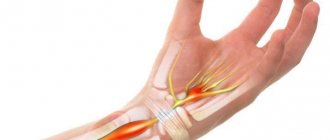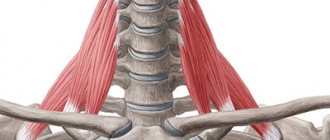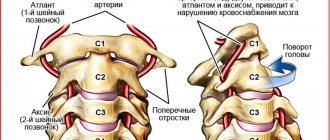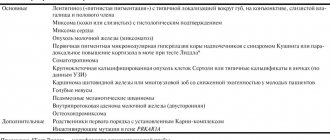General overview
Carpal tunnel syndrome (carpal tunnel syndrome) is a set of characteristic symptoms that occur when the median nerve is compressed in the wrist, ICD-10 code: G56.0. Includes numbness, paresthesia and pain in the zone of innervation of the median nerve. These sensations may be accompanied by objective changes in sensitivity and strength in the hand.
Diagnostics
The first line of diagnosis for numbness of the fingers in our clinic is electroneuromyography, this is especially true for carpal tunnel syndrome. To make a diagnosis, a combination of characteristic clinical signs and deviations from the norm found during electroneuromyography is necessary. Electrophysiological testing can also exclude other neurological problems (for example, in the cervical spine). With this study, it is possible to assess the severity of nerve damage, which helps in choosing further treatment tactics and determines the prognosis of the disease. An ultrasound scan can reveal masses that are putting pressure on the nerve.
MRI for carpal tunnel syndrome is prescribed exclusively for preoperative planning in cases of significant joint damage or neoplasms.
Treatment
There is evidence of the benefits of aerobic exercise and weight control in carpal syndrome. A bicycle or exercise bike is not the best exercise option, as it puts constant stress on your arms.
Using physical therapy such as ultrasound may provide temporary relief.
Many people with incipient syndrome (as measured by ENMG) usually respond well to the use of a night splint to maintain a neutral hand position during sleep (minimum three weeks).
Injection (blockade) with glucocorticoids, such as diprospan, shows good results if more conservative means do not work.
Patients who do not respond to conservative methods, or those who initially present with severe disease, are referred for surgical treatment.
Surgery for carpal tunnel syndrome (CTS) involves cutting the palmar ligament, which is compressing the median nerve. The success rate is very high (more than 90%), and the risk of complications is minimal. Recurrence after complete dissection of the palmar ligament of the hand is extremely rare. Surgical success is less likely for patients with normal electroneuromyography findings.
Symptoms of neuropathy of the radial nerve of the arm
The clinical picture of radial nerve neuropathies of the upper extremities will depend on the location of nerve compression.
The first type of neuropathy of the radial nerve of the arm
With this type, the armpit is damaged. The disease is popularly called “crutch paralysis.” The muscles of the forearm become immobilized and the process of impaired extension and flexion of the upper limb occurs. The triceps muscle atrophies.
Symptoms:
– Drooping of the hand when raising the arm;
– The first and second fingers are closed;
– There is difficulty in straightening the hand;
– Sensation in the fingers is lost and a state of numbness appears.
Type 2 radial neuropathy
Probably the most common radiation neuropathy of the hands. Occurs when a nerve is accidentally damaged:
– during deep sleep;
– with a shoulder fracture;
– prolonged uncomfortable position of the hand;
- when applying a tourniquet.
With strong pressure in the middle part of the forearm, there may be symptoms of neuropathy such as a feeling of numbness on the back of the hand. In addition, there is no way to straighten your fingers. However, extension movements in the forearm are preserved.
Third type of radiation neuropathy of the upper extremities
This disease involves damage to the posterior process of the nerve. This manifests itself in damage to the upper limb in the elbow area. Quite often one can observe a chronic course of neuropathy due to weakening of the joint ligaments and changes in the functioning of the hand muscles. If you straighten your elbow, you feel pain in the muscles of the forearm. Also, pain is felt when moving the hand.
There are also common symptoms of neuropathy of the radial nerve of the arm
Observing each type of neuropathy, accompanying and underlying symptoms may occur. The main symptoms have been listed above.
Associated symptoms:
– swelling at the site of the lesion;
– the occurrence of difficulties when performing motor actions with the hands;
– impaired coordination of hand movements;
– decrease in sensitivity;
– spasms and convulsions.
If you have similar symptoms and signs, you should urgently take action and begin treatment for neuropathy of the radial nerve of the hand.
Causes and pathophysiology of the process
Before the invention of electroneurophysiological testing in the 1940s, numbness in the fingers was more often attributed to compression of the brachial plexus by the cervical ribs or other structures in the anterior cervical spine. Now we know for sure that the median nerve is compressed in the inextensible rigid carpal tunnel, demyelination occurs (damage to the sheath of the nerve ending), and then damage to the axon itself. Sensory fibers are damaged first, motor fibers later. The ultimate mechanism of injury is still a matter of debate. At the moment, it is believed that the main problem is increased pressure inside the carpal tunnel. This pressure blocks venous outflow, swelling increases and even greater compression occurs, which ultimately leads to ischemia (lack of blood supply) to the nerve. The risk of occurrence may be associated with many factors: genetic, medical, social, occupational and demographic. Various combinations of these risk factors lead to the development of carpal tunnel syndrome, but at the moment we cannot confidently name a simple and clear cause.
Description of neuropathy
Compression-ischemic neuropathy of the radial nerve is one of the most common forms of this type of disorder. The occurrence of neuropathy is often associated with injuries to the upper extremities. The problem even occurs due to incorrect hand position during sleep.
The nature of the clinical picture of radial neuralgia is determined by the affected area. Disruption of the innervation of the fingers and the area on the palm side of the injured limb leads to the development of radial nerve palsy, in which a decrease or complete loss of sensitivity occurs. However, in this case, forearm extension is not impaired.
When selecting treatment methods, it is important to establish the presence of damage to the radial nerve, since a decrease in the sensitivity of the little finger and other fingers is often explained by impaired conduction of other nerve fibers.
Epidemiology
Disease frequency
The most accurate statistics are for the United States of America, where about 1–3 new cases of the disease are registered per 1000 people per year. On average, about 50 people out of 1000 suffer from carpal tunnel syndrome.
There is some lack of international statistics on this issue, but the prevalence of the syndrome in developed countries is similar to the United States, for example, in Holland there are about 2.5 new cases per year, and in the UK about 70-160 out of a thousand people ever seek help. Carpal syndrome is practically unheard of in developing countries, for example, among the indigenous population of South Africa.
Mortality/health threat
The disease is not fatal and cannot lead to a fatal outcome, but it can lead to serious irreversible impairment of hand function if correct treatment is not carried out.
It occurs more often in white Caucasian people.
It is believed that women suffer from carpal tunnel syndrome three times more often than men.
Peak occurrence occurs between 45–60 years. Only 10% of patients with this diagnosis are under 31 years of age.
Symptoms of the disease
Often, the history and complaints of hand disease are more important than examination data when diagnosing carpal tunnel syndrome.
Numbness and tingling
Most often, people complain that objects fall out of their hands, their hands become “wobbly” and “weak,” needles and goosebumps can become frequent guests in their fingers.
Signs of carpal tunnel syndrome appear during certain jobs or activities:
- behind the wheel;
- when reading a book/newspaper;
- when working at a computer;
- while writing or drawing.
At night, unpleasant sensations force you to wake up and shake your brush. Some note that they need to walk around and put their hand in cold/hot water. Bilateral carpal tunnel syndrome is quite common, with the dominant hand usually affected earlier and more severely than the other.
Localization
Complaints should be focused on the palmar surface of the wrist and hand in the 1-2-3 and half of the fourth fingers, this is the zone of innervation of the median nerve. Numbness of the little finger and the back of the hand is the area of responsibility of other nerves and is not typical for carpal tunnel syndrome. Surprisingly, many patients cannot localize their symptoms and complain of numbness/weakness in the entire arm, which does not exclude this diagnosis.
Pain
Loss of sensitivity may be accompanied by burning pain in the palm, which often spreads to the fingers or along the forearm, sometimes to the elbow.
Pain in the area of the epicondyles of the elbow and higher in the shoulder or neck makes you think about other problems of the musculoskeletal system with which carpal tunnel syndrome can be combined. Identifying the causes of these pains requires a more detailed diagnosis.
Signs related to the autonomic nervous system
Patients often complain about the entire hand: a feeling of fullness, swelling of the hand and fingers; the hand may freeze or, conversely, feel hot. Many people react to the ambient temperature and do not tolerate cold well. Sometimes a change in skin color is noticed. In rare cases, there are complaints of changes in sweating in the palm. All this is associated with a violation of parasympathetic innervation, since the median nerve contains a considerable number of autonomic nerve fibers.
Weakness, lack of coordination
Decreased hand strength, especially when gripping with the thumb, often accompanies the disease. This may be due to loss of sensory response or pain. Objectively, weakness of the flexor digitorum longus and flexor digitorum profundus occurs when the median nerve is compressed above the level of the carpal tunnel. During the examination, the doctor will help determine the level of compression and choose the treatment necessary for you.
Diagnosis of radial nerve neuritis
Damage to the radial nerve (as a result of surgery, injury, including after drug injection, blows and prolonged compression, bone fractures and joint dislocations) is accompanied by inflammatory changes in it and manifests itself as a violation of motor and sensory function in the zone of its innervation on the arm.
The motor fibers of the radial nerve innervate the extensors of the forearm, hand and fingers, the supinator of the forearm, the abductor pollicis muscle and the muscle involved in flexion of the forearm. Sensitive fibers of the radial nerve innervate the skin of the posterior surface of the shoulder, the posterior surface of the forearm, the side of the dorsal surface of the hand and partially the first, second and sometimes third fingers.
When the spinal nerves C7 or the middle trunk of the brachial plexus are damaged, the main function of the radial nerve is lost in combination with partial damage to the median nerve, its upper leg. Radial nerve neuropathy at this level manifests itself as a weakening of the forearm's medial rotation and palmar flexion of the hand. When the posterior bundle of the brachial plexus is damaged, the same basic functions of the radial nerve are lost, but in combination with damage to the axillary nerve.
Diagnosis of the level of damage to the radial nerve during neuritis is made using electroneurography (ENG).
With high damage to the radial nerve in the axillary fossa, in the upper third of the shoulder, paralysis of the extensors of the forearm, hand, main phalanges of the fingers, and the abductor pollicis muscle occurs; flexion of the forearm is weakened. The reflex from the triceps tendon fades and the carporadial reflex is somewhat weakened.
Sensitivity is lost on the back of the shoulder, forearm, partly the hand and fingers. The zone of sensory disorders on the hand is often significantly reduced due to the overlap of the zone with the innervation of neighboring nerves. The joint-muscular feeling does not suffer. At lower levels of damage, the function of the radial nerve suffers to a limited extent, since the higher branches of the radial nerve are preserved, which makes it easier for the neurologist and neurosurgeon to perform topical diagnosis of its damage.
Zones of skin innervation by the radial nerve.
Damage to the radial nerve (traumatic neuritis of the radial nerve) at the site of the humerus fracture.
When the radial nerve is damaged, which is very common, at the level of the middle third of the shoulder, the function of extension of the forearm and the extensor-ulnar reflex of the triceps are preserved and sensitivity in the shoulder is not impaired.
If the radial nerve is damaged in the lower third of the shoulder, the function of flexion of the forearm and sensitivity on the posterior surface of the forearm may be preserved, since the corresponding branches depart from the main trunk of the nerve higher, in the middle third of the shoulder.
The use of acupuncture is very effective in the treatment of radial neuritis.
When the radial nerve is damaged in the forearm, the function of forearm flexion is usually preserved; motor impairments with such damage to the radial nerve are limited to damage to the extensors of the hand and fingers with impaired sensitivity only in the hand. If the radial nerve is damaged even lower, at the level of the middle third of the forearm, motor dysfunction may be even more limited; if extension of the hand is preserved, only extension of the main phalanges of the fingers may suffer.
When the radial nerve is damaged (radial nerve neuropathy), weakness of the wrist extensors develops, and a typical falling or drooping hand occurs.
Among the numerous descriptions of samples or tests that determine movement disorders with damage to the radial nerve, the following can be noted:
- Inability to straighten the hand and fingers
- Inability to abduct the thumb.
- When the hands are folded together with the fingers straightened, the fingers of the affected hand are not retracted, but the bent ones seem to “slide” along the palm of the healthy, retracted hand
What can be found during inspection?
Clinical examination is very important to exclude other pathologies of the musculoskeletal system or nervous system. Also, during the examination, you can identify characteristic signs of the disease to draw up a further examination plan.
Sensitivity tests
Changes in sensitivity can be observed along the palmar surface of fingers 1-2-3 and along the radial surface of the fourth finger. There is a Semmes-Weinstein test, a two-point discrimination test. The most commonly used test in practice is a prick test.
Sensory assessment confirms that areas outside the median nerve innervation are normal.
Strength tests
Weakening or loss of function of the following muscles: 1-2 lumbricals, oppons pollicis, flexor brevis, and abductor pollicis brevis indicate damage to the motor fibers of the median nerve distal to the carpal tunnel.
Special tests
There are no 100% reliable clinical tests to confirm carpal tunnel syndrome; a combination of them is evaluated.
- Tinel's sign. Gently tapping over the carpal tunnel causes shooting sensations in the fingers. It is the most common symptom in daily practice, despite its low sensitivity and specificity.
- Phalen's sign. Tingling/numbness occurs in the fingers when bending the wrist for 1 minute. The sensitivity of this test is 80%, the specificity is slightly lower.
- Wrist pressure test. When pressing on the wrist area with your thumb for 30 seconds, symptoms characteristic of nerve compression appear/intensify. Sensitivity 89%, specificity 96%.
- Palpation. The soft tissue surrounding the wrist is palpated for masses or other mechanical causes of nerve compression. Sensitivity reaches 90%, specificity 75% or more.
- Measurements to eliminate “square wrists”. If the thickness of the wrist in relation to its width has a proportion of more than 0.7, then the probability of developing carpal tunnel syndrome is about 70%.
Symptoms
With neuritis, the nerve fiber is damaged, and therefore the functions suffer, the main ones being sensitive, motor and trophic, therefore the following symptoms are clinically noted:
- In the phase of irritation of the nerve fiber: pain, burning, feeling of “crawling goosebumps”, feeling “as if many needles are being pricked”.
- In the phase of loss of functions: decreased muscle strength, muscle atrophy, decreased reflexes, decreased sensitivity, tissue atrophy including skin, subcutaneous fat, muscles, bone tissue.
Causes
It is worth mentioning from the outset that carpal tunnel syndrome can be associated with various factors. On the one hand, it can be noted that the symptoms are more pronounced after or during the load on the hand, on the other hand, it cannot be said that the load on the hand is the cause or causes the disease. Associated does not mean is the cause.
Demography:
- Elderly age
- Female
- Increased body mass index, especially after rapid weight gain
- “Square” wrist shape
- Brachymorphic type of body structure (short arms, short legs)
- Dominant hand
- White Caucasian
Many factors are inherited (“square” wrist, thick palmar ligament, body type). Also, conditions associated with carpal tunnel syndrome have a hereditary predisposition (diabetes, thyroid disease, nephropathy, neuropathy).
Diseases/medical problems:
- Fractures of the distal radius
- Acute wrist injury (sharp flexion/extension)
- Neoplasms, injuries occupying a place in the carpal tunnel (tenosynovitis of the flexors, hygromas, hematomas, aneurysms, abnormal muscles, various tumors, edema)
- Diabetes
- Thyroid disorders (usually myxedema)
- Rheumatoid arthritis and other inflammatory diseases of the wrist joint
- Recent menopause
- Hemodialysis
- Acromegaly
- Amyloidosis
Carpal tunnel syndrome due to specific stress on the hand:
- Long power grip
- Prolonged stay in an extremely uncomfortable position
- Repeating the same movements multiple times
- When using the mouse and keyboard for a long time
- Prolonged exposure to vibration/cold
Other development factors:
- Lack of aerobic exercise
- Pregnancy and breastfeeding
- Using crutches/walkers/canes
Causes of radial nerve neuropathy
One of the main causes of neuropathy of the radial nerve of the arm is prolonged compression. This may happen due to the following factors.
– uncomfortable or incorrect posture during sleep;
– compression of the upper limbs with crutches;
– prolonged squeezing of the hand with a tourniquet;
– wearing handcuffs;
– prolonged sharp bending of the elbow while running;
– injections into the shoulder area. This is only possible if the nerve location is abnormal;
- fracture of the shoulder bone.
In some cases, radiation neuropathy of the arm is a consequence of:
– Alcohol poisoning during long drinking bouts;
– Hormonal imbalances in women and pregnancy;
– Intoxication of the body with lead;
– Past infectious diseases;
– Development of diabetes mellitus.
The cause of a violation of the radial nerve of the upper extremities can be a person’s professional activity. For example, among the sick there are a huge number of people whose activities involve physical manual labor.
Remember! There are cases where neuropathy of the radial nerve of the extremities occurs in professional athletes. Prolonged tension in the hands can lead to disruption of the functioning of nerve formations.
Instrumental/laboratory diagnostics
Laboratory tests
There are no blood tests to diagnose carpal tunnel syndrome, but they may be ordered to screen for underlying conditions (such as diabetes or rheumatoid arthritis).
Radiation diagnostics
Radiation diagnostics is not used in routine practice.
MRI of the wrist may be useful in preoperative preparation to identify the causes of mechanical compression of the median nerve. Changes in the MR signal can be observed with chronic nerve compression, but they do not yet have practical significance for determining treatment tactics for the disease.
Many specialists now use ultrasound in addition to electrophysiological research methods. Ultrasound can reveal pathological processes that occupy space in the carpal tunnel, confirm changes in the median nerve (increase in cross-sectional area), which really help in diagnosis.
Electroneurophysiological studies
Electroneuromyography is the first-line diagnostic tool for carpal tunnel syndrome. Abnormalities found on ENMG in combination with specific symptoms and tests are the key to the correct diagnosis. Electroneuromyography can also exclude other neurological disorders.
Electrophysiological studies can also determine the extent of nerve damage, which is an objective criterion for prognosis.
Carpal tunnel syndrome is usually divided into mild, moderate and severe. The ranges for these groups may vary depending on the laboratory. In general, patients with isolated sensory disorders belong to the mild group, and if motor dysfunction occurs, they move to the moderate group. Confirmation of axonal damage (markedly decreased or absent sensory/motor response distal to the carpal tunnel) indicates severe disease.
Tracking the dynamics during ENMG helps determine the further approach to the disease.
Other quantitative tests, such as thermography or vibrometry, are less informative compared to ENMG and are not recommended for practical use.
Treatment
Physical therapy
Since carpal tunnel syndrome has been shown to be associated with obesity and low mobility, correcting these factors will help improve the condition. An exercise bike, a bicycle and other exercises requiring prolonged grip are not indicated for this disease.
The use of physiotherapy devices may provide temporary relief. For example, short-wave diathermy provides significant temporary improvements compared with placebo, including reduction in symptoms and pain, and improvement in hand function.
Ergonomics and hand therapy
Wrist braces, which keep the hands in the correct position, have been shown to be effective as an at-home treatment when used at night for a minimum of 3 to 4 weeks.
They are inexpensive and safe, so in the initial diagnosis of the disease, a neutral night splint should be considered first.
Specific muscle strengthening programs and gliding exercises have not been shown to be effective. Massage and manual techniques that improve nerve glide have no proven therapeutic effect. Changes in the ergonomics of the workplace (table, chair, body position settings), changing equipment or tools are not effective in cases where the syndrome has already been confirmed.
Making a custom tire
Most people with early stage hand tunnel syndrome respond well to conservative therapy, which primarily consists of using a night brace for three weeks. Ready-made splints from orthopedic stores can provide improvement, but individual ones are more convenient and more effective, and therefore are preferable. It can be said that a special plastic splint molded to the patient's hand (orthosis) is the best choice for the initial treatment of carpal tunnel syndrome.
Drug therapy
Steroid injections into the carpal tunnel have been shown to be effective over the long term when other treatments have failed. Blockades can be indispensable in case of contraindications to surgical treatment, for example, during pregnancy. Ultrasound measurements of the median nerve of the arm predict the effectiveness of steroid blocks. Ultrasound navigation when performing a blockade does not lead to a reduction in complications or an increase in the effect of the blockade.
Anticonvulsants such as gabapentin or pregabalin, which are prescribed for various neuropathic pain, may also be used for carpal tunnel syndrome.
Nonsteroidal anti-inflammatory drugs (NSAIDs) and/or diuretics sometimes have some effectiveness in patients with special conditions (fluid retention or flexor tendon tenosynovitis)
However, in general, for all patients with carpal tunnel syndrome, the effectiveness of gabapentin, diuretics, or NSAIDs is controversial. According to the American Orthopedic Association guidelines, systemic medications (pills, intramuscular injections, IVs) are no more effective than placebo for treating carpal tunnel syndrome. In addition, it is worth noting that supplements with B vitamins (B-6 and B-12) also do not provide proven benefits.
Treatment of neuralgia
After diagnosing a pinched radial nerve in the arm, treatment is carried out taking into account the nature of the lesion. Priority problems come to the fore when selecting a treatment regimen. In particular, drugs are first used to stop the inflammatory process and complications of toxic damage to the body, or other procedures are used to eliminate the consequences of a fracture or other severe injuries. In the latter case, limb immobilization and surgical intervention are more often used.
If neuralgia is caused by external factors, such as the use of crutches, you must stop using them for the duration of treatment. Treatment of neuropathy is usually carried out on an outpatient basis. More often, patients are admitted to the clinic if they require the administration of strong drugs or surgery for a fracture.
Various medications are used to treat radial neuropathy. The basis of therapy is non-steroidal anti-inflammatory drugs: Ibuprofen, Diclofenac and others. Treatment of the radial nerve of the hand is complemented by antibiotics, which suppress the activity of the bacterial microflora that causes inflammation. At the same time, taking decongestant drugs such as Hydrocortisone or Diprospan is indicated.
Regardless of the cause, radial nerve palsy is treated with:
- vasodilators that increase blood flow to the affected area;
- anticholinesterase drugs that restore radial nerve conduction;
- B vitamins that stimulate the regeneration of damaged tissues;
- vasoactive drugs (nicotinic acid, Pentoxifylline) that normalize metabolism.
In case of acute poisoning of the body, detoxification is indicated, which is carried out using intravenous injections of glucose and sodium chloride solutions.
In case of post-traumatic neuritis of the radial nerve of the hand, recovery after a fracture involves repositioning the bones and other procedures through which the previous skeletal structure is restored. Also, for such disorders, physiotherapeutic procedures are used: acupuncture, magnetic therapy, massage and others.
In case of a violation of the innervation of the radial nerve with damage to the arm or hand, the use of traditional medicine is justified if drug treatment is carried out. Herbal preparations relieve only the symptoms, but do not eliminate either the cause of the development of neuropathy or the disorder itself.
propolis
red clay
Treatment of the radial nerve with folk remedies is carried out using:
- Propolis. The product is used in the form of compresses. To prepare the medicinal composition you will need 40 grams of propolis and 100 ml of 96 percent alcohol. After mixing, the solution is infused in a dark place for a week. During this period, it is necessary to shake the composition regularly. At the end you need to add corn or olive oil in a 5:1 ratio. A compress with this remedy is applied for 10 days.
- Red (pottery) clay. It must first be mixed with vinegar and rolled into a flat cake. The clay should then be applied to the problem area overnight for three days.
- Raspberries. You will need a tablespoon of chopped stems and 250 ml of boiling water. The mixture is simmered over low heat for 5 minutes. Next, the product is infused for half an hour. It is recommended to drink the resulting composition three times a day half an hour before meals.
Damage to the radial nerve of the arm is treated with bear lard, which must be rubbed into the problem area for four weeks. A good effect is achieved by applying horseradish leaves to the hand. Also, treatment of the radial nerve can be supplemented with an infusion of fireweed tea (a tablespoon of the plant per 250 ml of boiling water, infused for 8 hours in a thermos).
For neuropathy of the radial nerve, a set of physical exercises is indicated, with the help of which the lost functions of the limb are restored. Exercise therapy is selected individually. Damage to the radial nerve can be eliminated using the following exercises:
- Bend your arm at the elbow and rest your limb on a hard surface, maintaining a right angle between the support and your forearm. Thumb down, index finger up. Repeat the exercise 10 times.
- Hand position as in exercise No. 1. Index finger down, middle finger up. Repeat the exercise 10 times.
- Grasp the lower phalanges of four fingers with your healthy palm, leaving the thumb aside. Bend and straighten your palm 10 times. Grab the upper phalanges and repeat the steps. Finally, with your healthy hand, clench the fingers of the affected limb into a fist 10 times.
Treatment of a pinched nerve in the hand has a good effect if the patient performs the following exercises in water:
- Press with healthy fingers on the phalanges of the patients, straightening them completely.
- Extend the sore fingers or spread them to the sides with the healthy hand.
- Raise and lower the sore fingers (except for the thumb), straightening the phalanges.
- Make circular movements with each finger.
- Place a towel on the bottom of the bathtub and squeeze it into a fist with your sore hand.
It is highly not recommended to perform the described exercises without consulting a doctor. Failure to comply with this rule can lead to serious consequences. Of particular danger are cases when the patient refuses to follow medical recommendations after nerve repair.
Neuropathy of the radial nerve of the hand is often accompanied by an inflammatory process in the problem area. To stop the latter, it is necessary to speed up blood circulation and restore metabolism. This can be achieved by performing massage for radial nerve neuritis.
The procedure is carried out no more than 15 times. It is forbidden to perform massage actions on your own, as this can cause serious injuries.
Surgery
Sign up for a consultation
In patients for whom conservative therapy has failed, or for those who initially come to the appointment with a severe degree of carpal tunnel syndrome (according to ENMG), there are indications for surgery. Surgical dissection of the palmar ligament is highly likely (more than 90%) to lead to significant improvement with a low complication rate. The success of surgical treatment is reduced for people with normal electromyography.
Carpal tunnel decompression surgery is performed under local anesthesia in an outpatient operating room. This operation does not require hospitalization or the participation of an anesthesiologist.
The operation can be performed using a classic wide approach, as well as minimally invasive with or without the use of endoscopic equipment. The long-term results of a correctly performed operation are comparable for different methods of intervention.
The details of the surgical intervention and its necessity in your case should be discussed with a hand surgeon.
What to do after detection?
When conservative therapy for carpal tunnel is initially prescribed, a follow-up consultation with a specialist is required within 4–6 weeks to assess effectiveness.
Patients who have not achieved the desired result with conservative treatment should be referred for surgical decompression of the carpal tunnel.
If symptoms persist after surgery, ENMG monitoring is required.
Re-appointment of the study should be done no earlier than 3 months after surgery.
Prevention
There are no proven effective methods of prevention for carpal tunnel syndrome.
Complications
Without treatment, the median nerve continues to be damaged, leading to permanent impairment of hand function and helplessness. If left untreated for a long time, some people develop constant pain in the wrist and hand.
Forecast
Carpal tunnel syndrome usually progresses over time and can lead to permanent damage to the median nerve. Whether a conservative approach can prevent progression is currently unclear.
Even after surgical decompression of the carpal tunnel, partial return of CTS symptoms after several years is possible (about a third of patients within 5 years).
If detected early, up to 90% of patients experience improvement with conservative treatment, which does not preclude the need for surgery in the future.
Patients with comorbidities (diabetes or radius fracture, etc.) have a relatively worse prognosis compared to those who do not have such factors.
Patients with normal ENMG findings are less likely to improve after surgery compared with those with confirmed median nerve compression.
Patients with confirmed axonal injury have a poorer prognosis for complete nerve recovery.








